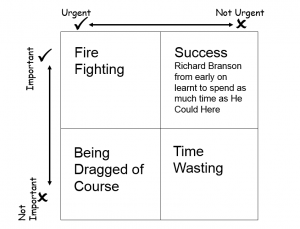The chart comes from Stephen Covey’s book The Seven Habits of Successful People, but Covey actually learnt the principles of this from Dwight D. Eisenhower’s Decision Matrix.
Something that Eisenhower used through his life as a General then President. He’s even quoted as saying. “What is important is seldom urgent, and what is urgent is seldom important.”

So looking at this chart, how much of what you do is in the ideal box of not urgent but important? That’s success. The planning and information work which is essential for building your clinic.
It’s okay to cross over to the urgent and important box sometimes: clients may need prompt help, situations you can’t plan for may occur, or on occasion you may need to change your plans at the last minute. But many clinical staff and owners actually spend too much of their day dealing with urgent but not important tasks like emails and some calls, or even worse.
You may get some team members slipping into the time wasting activities like chatting by the water cooler or random social media activities that have no strategy behind them so are not driving the business forward. Ultimately, one thing you do have to get good at is planning – that’s the important but not urgent stuff – and this is where all the super-successful spend the majority of their time.
You need a daily, weekly, monthly, and yearly action list and it will soon become a habit. It’s something that you need to get your team involved with too, so that they understand what’s important and why you’re doing it.
I always advise that you host a weekly meeting and then a once a month overview of how the strategies that you’re employing are working and where you are as a clinic. Depending on the size and type of clinic you’re running, simply tracking what your team are spending their time doing can be critical.
You may be using one of the industry-specific project management tools or even a paper based one, but if you’ve not really started tracking exactly where your clinics time is being spent yet, start now. There’s a very simple project management and time tracking tool called Toggl that will allow you to track what your team are doing and for whom they’re doing it, so it’s worth an explore.
If you’re looking to increase efficiency, though, where should you begin? It all starts with a routine, and getting you and your team to block out your day so that you focus on whatever it is that you need to be doing with no distractions.
Schedule to pick up and respond to your emails just twice a day – perhaps from 10am till 11am, and 3pm till 4pm, then set aside some more time to return calls. You may wish to do this once a day but limit it to a maximum of three a day regardless. Then block out the rest of the stuff you need to do around this.
By Alan Adams The Clinic Coach




